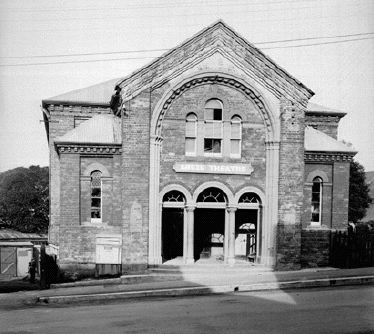Joseph Lester was transported as a convict to Sydney Town aboard the SS Somersetshirein 1814. He duly arrived in Hobart Town on 17 July 1815 aboard the SS Emu. He ran a number of public houses and became a Master of the Operative Lodge in 1834. In 1852 he was granted the block of land in Bathurst Street on which The Playhouse stands today.
During this period in England, a young and enthusiastic Minister named The Rev. John Wilkes Simmons was about to take charge of a growing church in Buckinghamshire: the foundation Church of the Congregational Sect founded in 1660 in Onley, Bucks. Simmons was ordained on 19 February 1856 and in 1860 was appointed Missioner to the Southern Seas. Owing to ill health, however, he had to cease his journeys upon arrival in Hobart Town in 1861. Realising that there was a need for religious preaching within the working classes, he set about converting these humble people, first preaching in a dance hall in Bathurst Street, and later becoming well-known for his Sunday afternoon lectures at the Theatre Royal. By 1863 his congregation had grown to such a size that they resolved to build a new church and the land in Bathurst Street was purchased from Joseph Lester with monies donated by friends and members of the congregation.
Henry Bastow, a respected local architect, was asked to design a chapel to suit their requirements, and James Gregory was commissioned to build the Chapel at a cost of £1484. The Foundation Stone was laid on 5 January 1864 by The Hon William Carter MLC, in the presence of the Church officials and a large crowd of onlookers. The Advertiser reported the occasion and gave a full description of the building.
The design of the building, which is Italian in character, has been made to suit the peculiarity of the site. The plan consists of a large nave which is circular at the South end and approached from the street by an open vestibule. Staircases to an end gallery are also arranged from this vestibule. The total length of the building is 85 ft. The platform, which has been substituted for a pulpit, is placed within a small apse at the South end of the Chapel and communicates on each side with a small vestry. The material used is red brick, relieved, however, by the used of brownstone in the construction of the North or principal front, and in the window dressings throughout. A cornice of brick is carried around the whole building at the eaves. The roofs are shingled and the ceiling of the Chapel is formed by plastering beneath the curved ribs of the roof. A bold cornice encircles the building under the ceiling. The seats are low open benches of deal, stained and varnished, and a slight fall toward the platform has been given to the floor. A tower which was originally part of the design has now been omitted. The accommodation provided is for four hundred and ninety persons, but in an emergency six hundred might be seated.
The Rev Simmons remained at the Chapel for thirty-six years until his retirement in 1899. Shortly after his death in 1900, the Chapel became the Helping Hand Mission under the control of the Congregational Union. In July 1935 the building was sold to a small syndicate who then operated the building as the Amuzu Cinema until 1938 one year after the Hobart Repertory Theatre Society purchased the building and renamed it The Playhouse Theatre. The Society used cash reserves to fund the necessary additions and alterations, costing £5700, and the first production in the ‘new’ theatre was William Shakespeare’s The Taming of the Shrew, directed by Miss Olive Winton, the 1927 Founder of the Society.
Since its purchase of the building in 1937, the Hobart Repertory Theatre Society has maintained The Playhouse, carrying out extensive renovations and improvements to this fine old building. The Playhouse has seen hundreds of fine productions and has been the training ground for dozens of actors, directors and playwrights who have gone on to national and international acclaim, and many hundreds more who have been able to provide for the Citizens of Hobart a regular program of live theatre for all these years.
Find out more about hiring The Playhouse Theatre
The Playhouse Theatre then

The Playhouse Theatre now
